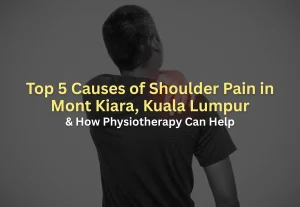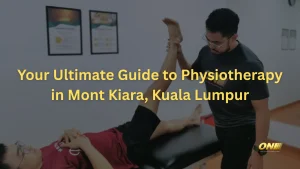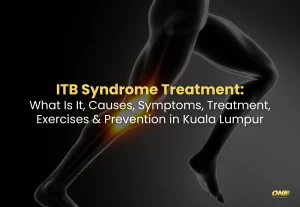Introduction
An ACL (anterior cruciate ligament) tear is a common yet serious knee injury, particularly among athletes and active individuals. Whether you’ve experienced it on the football field, during a basketball game, or simply from an unexpected twist, knowing what to do next is essential.
This blog post will guide you through everything you need to know about ACL tears—what they are, their causes, symptoms, treatment options, and how to prevent them. If you’re in Mont Kiara, Kuala Lumpur, or nearby areas like Sri Hartamas or Petaling Jaya, ONI Physio Fitness is here to help you get back on your feet.
What Is an ACL Tear?

The ACL is one of the four major ligaments in your knee, playing a critical role in stabilizing the joint. It connects your femur (thigh bone) to your tibia (shin bone) and helps control forward and rotational movement.
An ACL tear occurs when the ligament stretches beyond its capacity, often resulting in a partial or complete tear. This injury can severely impact your ability to walk, run, or participate in sports.
What Causes an ACL Tear?
Several activities can strain the ACL, making it susceptible to tears:
- Sudden Direction Changes: Quick pivots or side-stepping in sports like basketball or soccer.
- Improper Landing: Landing awkwardly after a jump in volleyball or gymnastics.
- Direct Impact: Collisions or tackles, often seen in football and rugby.
- Overextension: Hyperextending the knee during activities or accidents.
- Weak Supporting Muscles: Inadequate strength in the quadriceps and hamstrings can put more strain on the ACL.
Symptoms of an ACL Tear
An ACL tear often presents with the following signs:
- A Popping Sound: Many individuals report hearing a “pop” at the time of injury.
- Severe Pain: Immediate and intense pain, particularly at the center of the knee.
- Swelling: Rapid swelling occurs within hours of the injury.
- Instability: Feeling like your knee might “give way,” especially during weight-bearing activities.
- Limited Range of Motion: Difficulty straightening or bending the knee fully.
If you experience these symptoms, consult a physiotherapist or orthopedic specialist immediately.
Common Populations with ACL Tears
Certain groups are more prone to ACL injuries, including:
- Athletes: High-impact sports like soccer, basketball, and skiing put significant strain on the knees.
- Active Adults: Individuals who frequently engage in recreational sports or high-intensity workouts.
- Women: Women have a higher risk due to anatomical differences, such as a narrower intercondylar notch and hormonal factors affecting ligament flexibility.
ACL Tear Treatment
Effective treatment depends on the severity of the tear and your lifestyle goals.
1. Physiotherapy
Physiotherapy is essential for recovering from an ACL tear. At ONI Physio Fitness, our physiotherapists will develop a personalized rehabilitation program focusing on:
- Restoring knee strength and stability.
- Improving range of motion.
- Preventing future injuries.
2. Surgical Intervention
In severe cases or for athletes aiming to return to competitive sports, ACL reconstruction surgery may be necessary, followed by physiotherapy to regain full functionality.
Watch the video below to learn more about how ONI Physio Fitness helps patients with ACL tear to restore their functionality and strength:
Exercises for ACL Tear
Note: Always consult a physiotherapist before attempting these exercises.
Quadriceps Set
- Sit with your leg straight and a rolled towel under your knee.
- Tighten your quadriceps (thigh muscles) to press the back of your knee into the towel.
- Hold for 5-10 seconds, then relax.
- Repetitions: 10-15 times per session.
Heel Slides
- Lie on your back with both legs straight.
- Slide your injured leg’s heel toward your buttocks as far as is comfortable.
- Slowly return to the starting position.
- Repetitions: 10-15 times per session.
Glute Bridge
- Lie on your back with knees bent and feet flat on the floor.
- Squeeze your glutes and lift your hips toward the ceiling.
- Lower your hips back to the floor.
- Repetitions: 12-15 times per session.
Prevention of ACL Tear
Preventing an ACL tear involves strengthening muscles, improving flexibility, and practicing proper techniques.
- Strength Training: Focus on your quadriceps, hamstrings, and glutes to support the knee joint.
- Plyometric Exercises: Drills like jumping and hopping improve landing mechanics and reduce stress on the knees.
- Warm-Up: Always warm up before sports to prepare your muscles and ligaments.
- Proper Footwear: Wear shoes suitable for your sport to ensure stability and support.

Conclusion
An ACL tear can disrupt your life, but with the right treatment and care, recovery is possible. At ONI Physio Fitness, our experienced physiotherapists specialize in helping you regain strength, stability, and confidence in your knee. Whether you’re an athlete or someone who leads an active lifestyle in Mont Kiara, Kuala Lumpur, or nearby areas, we’re here to support you on your recovery journey.
Take the first step to recovery—book your physiotherapy appointment with ONI Physio Fitness today!

















